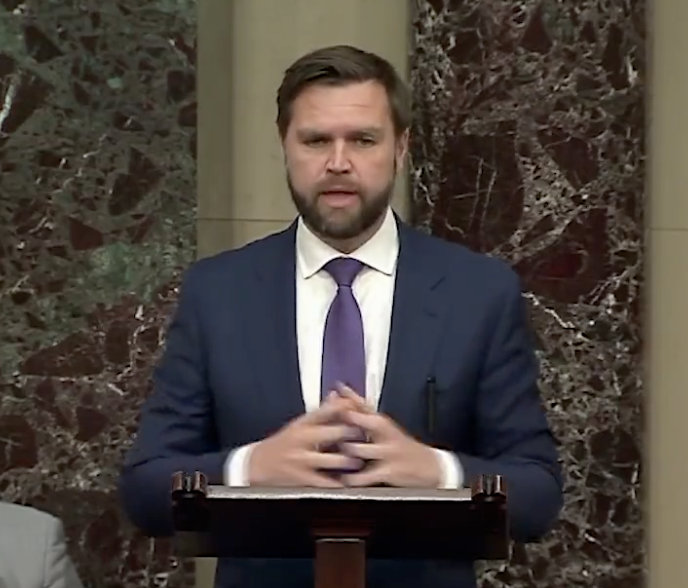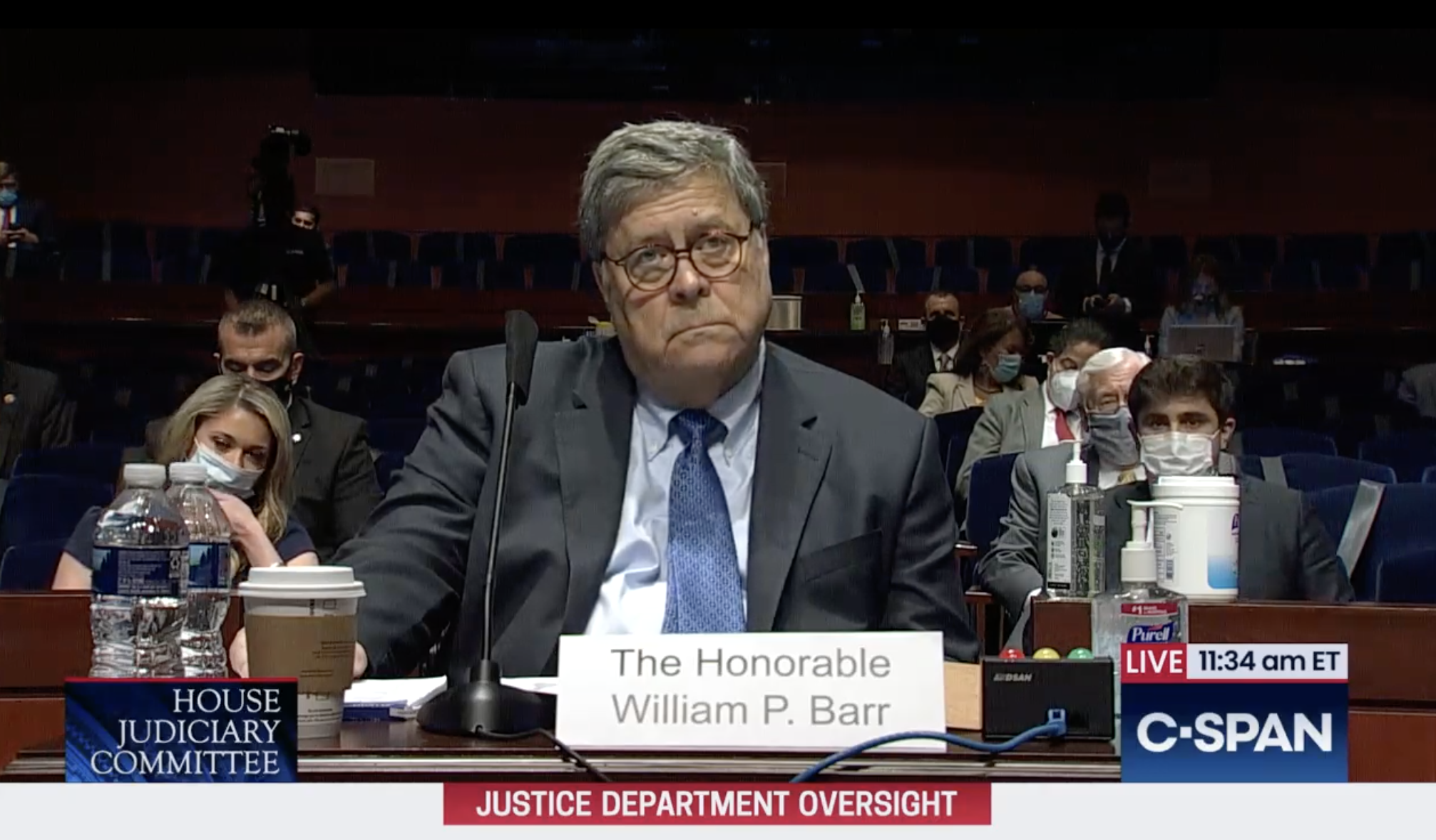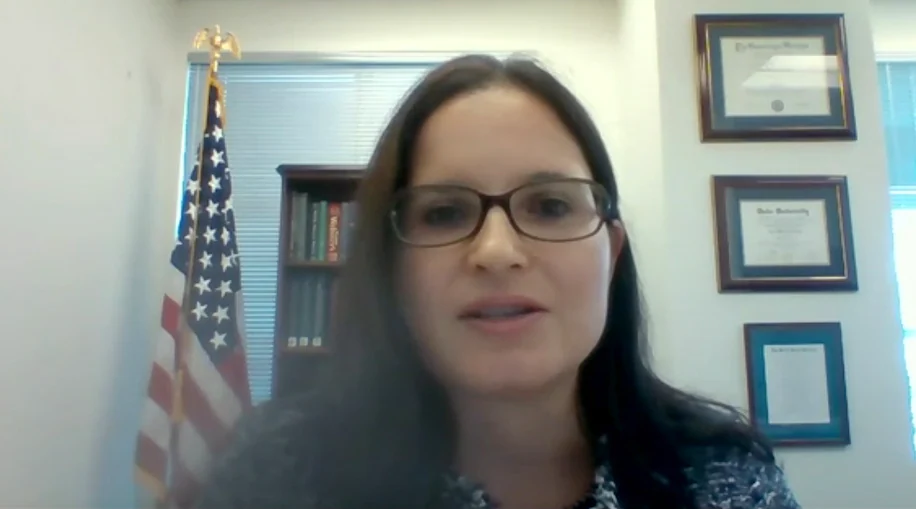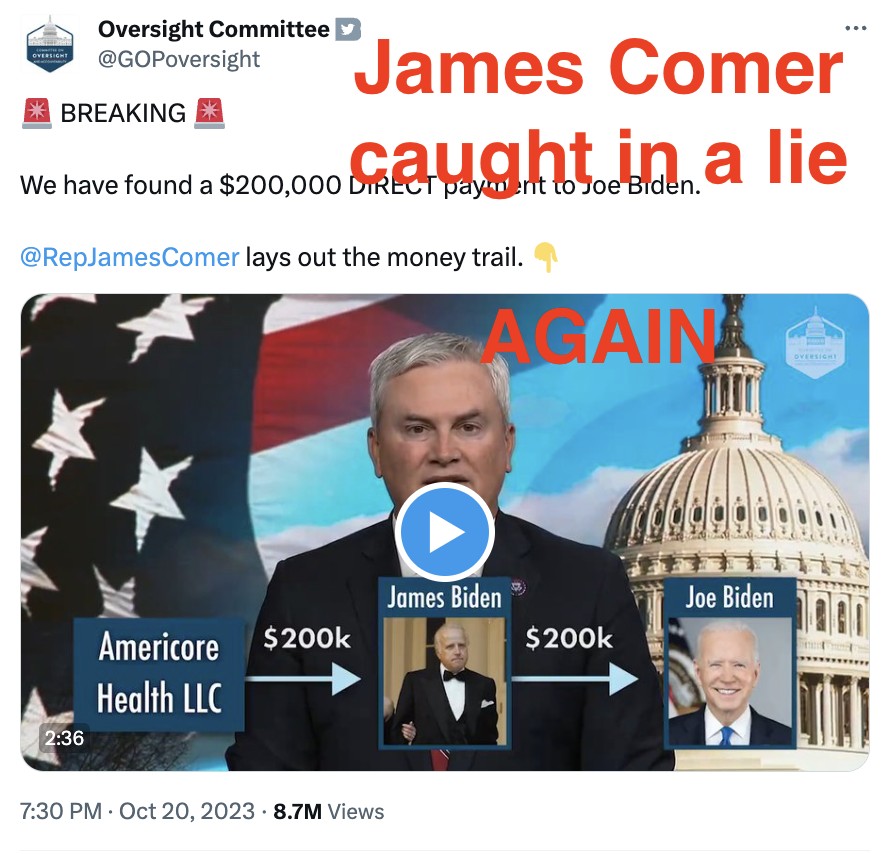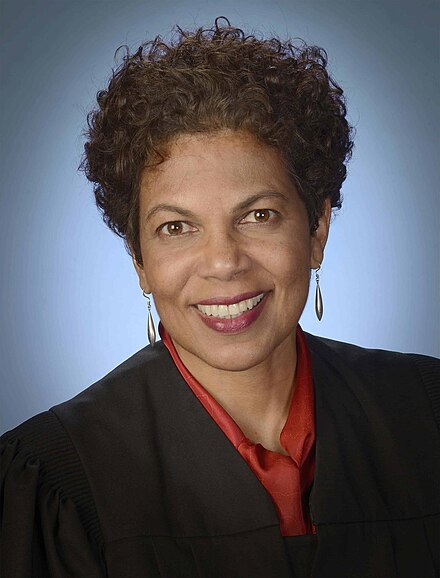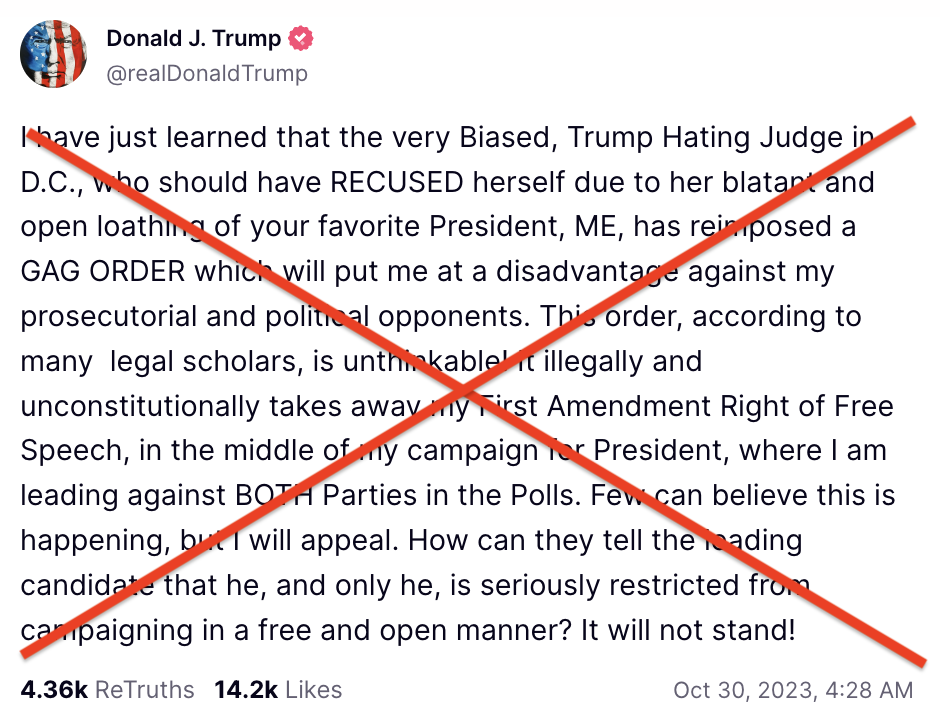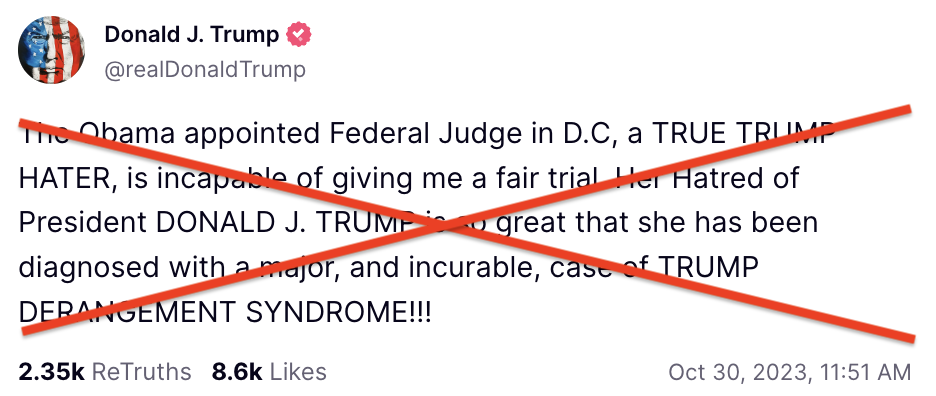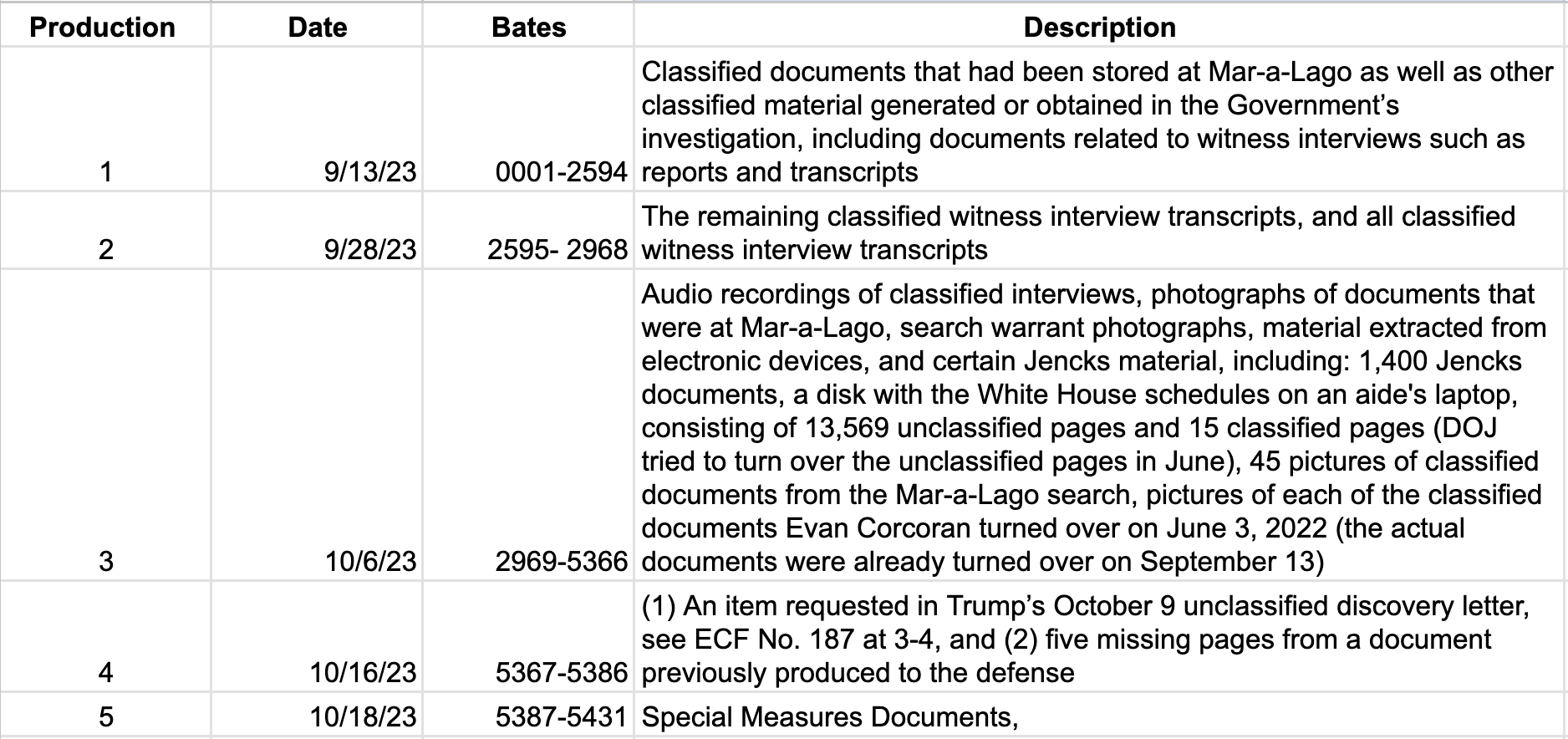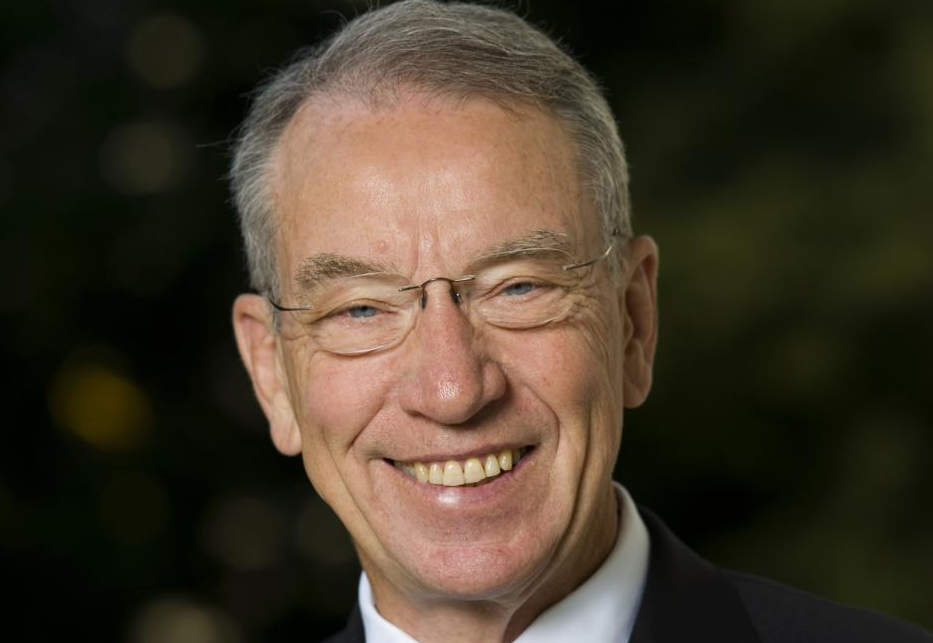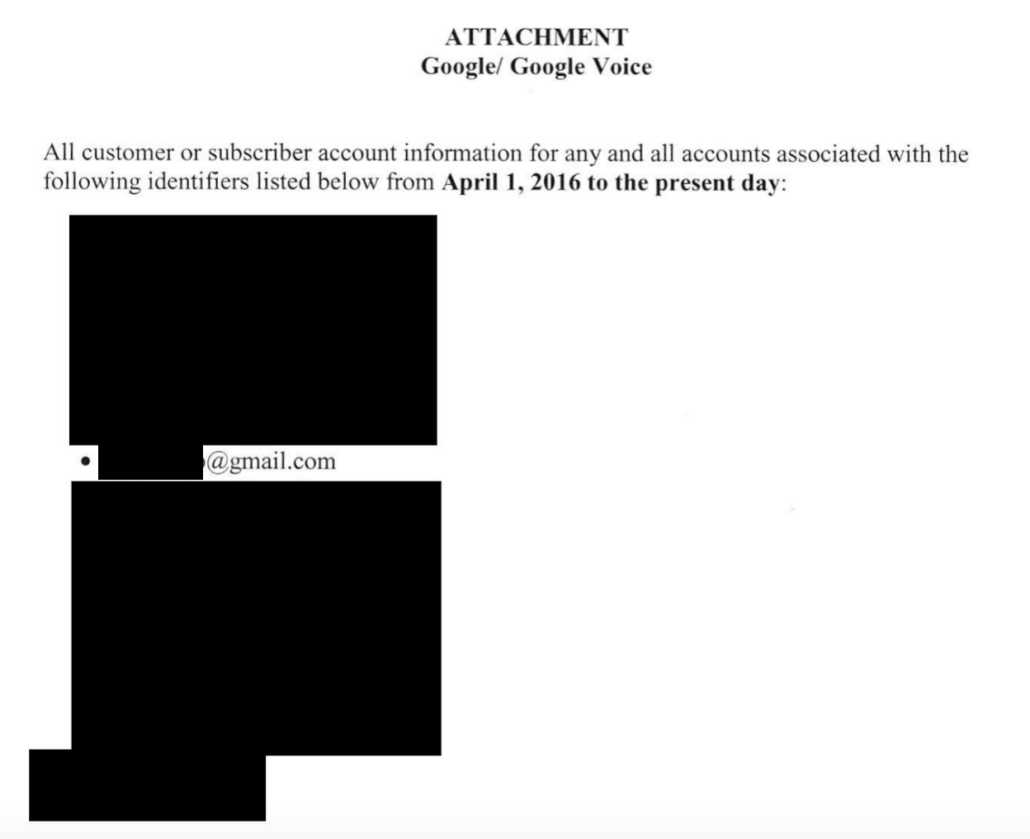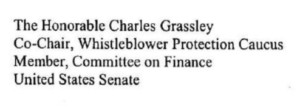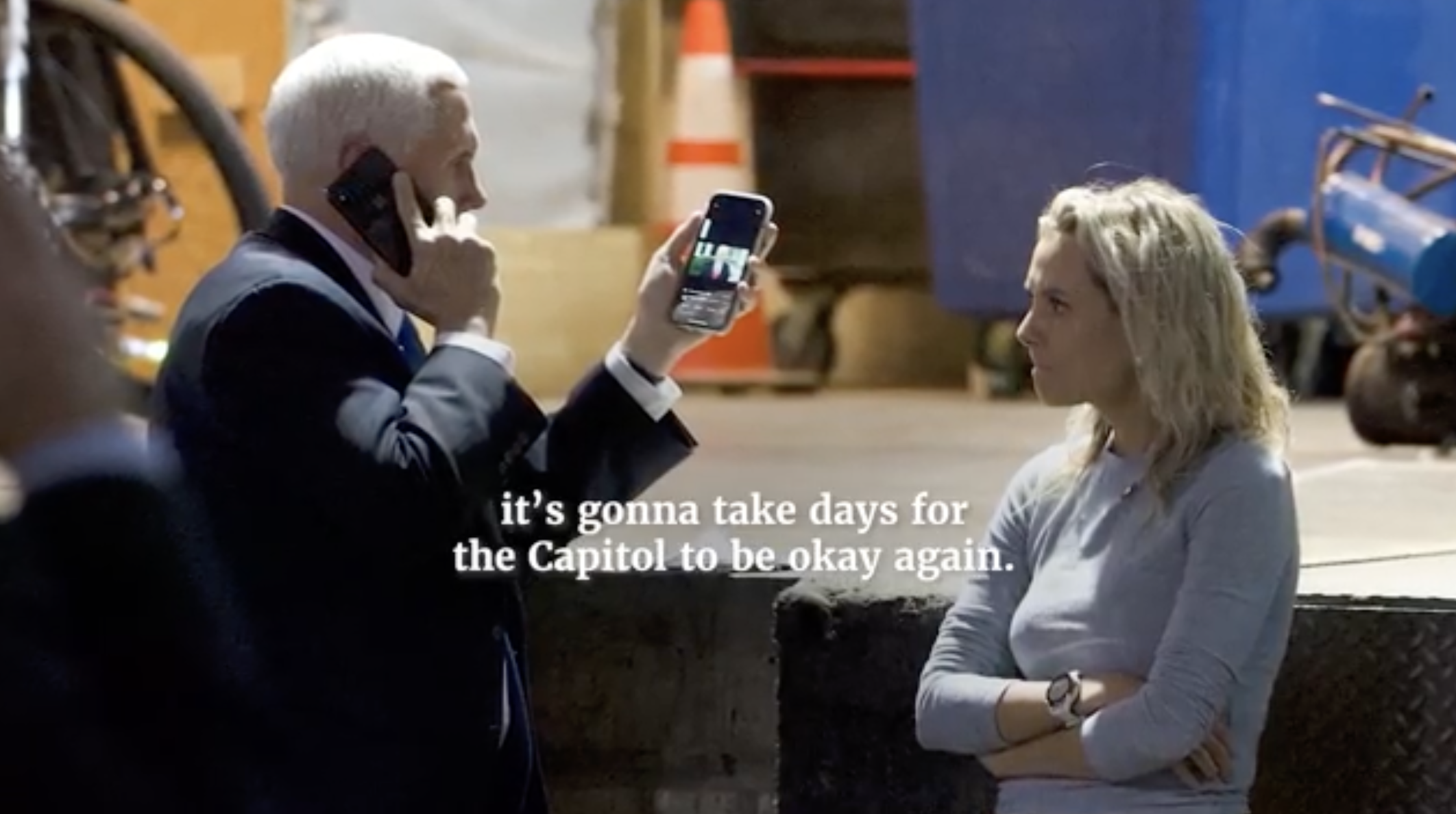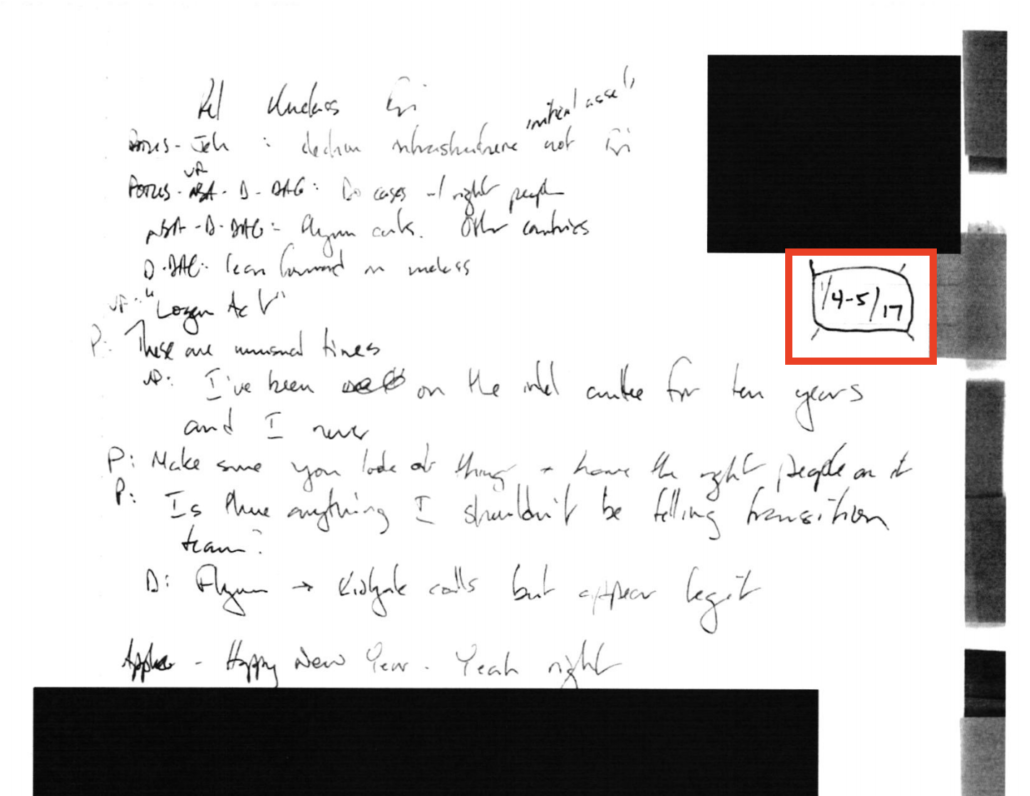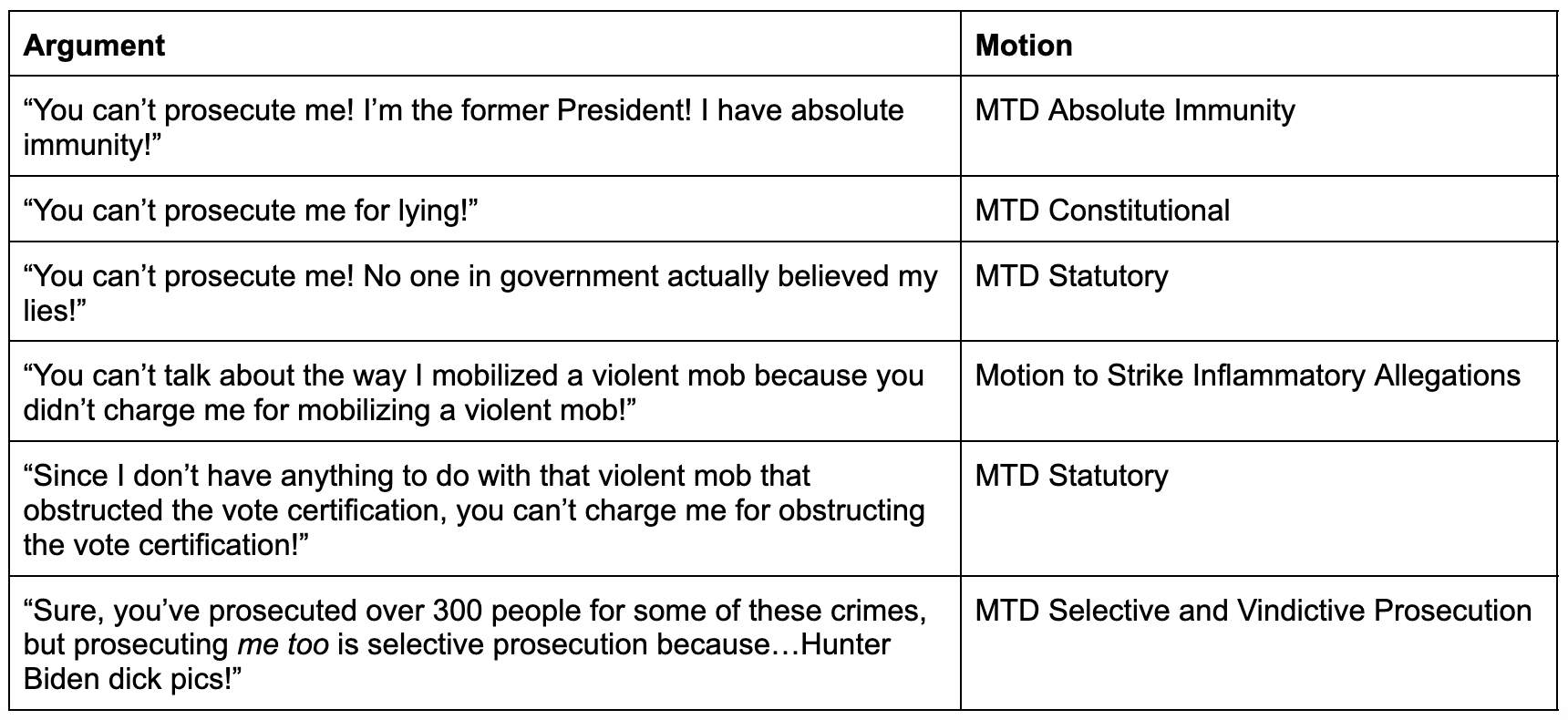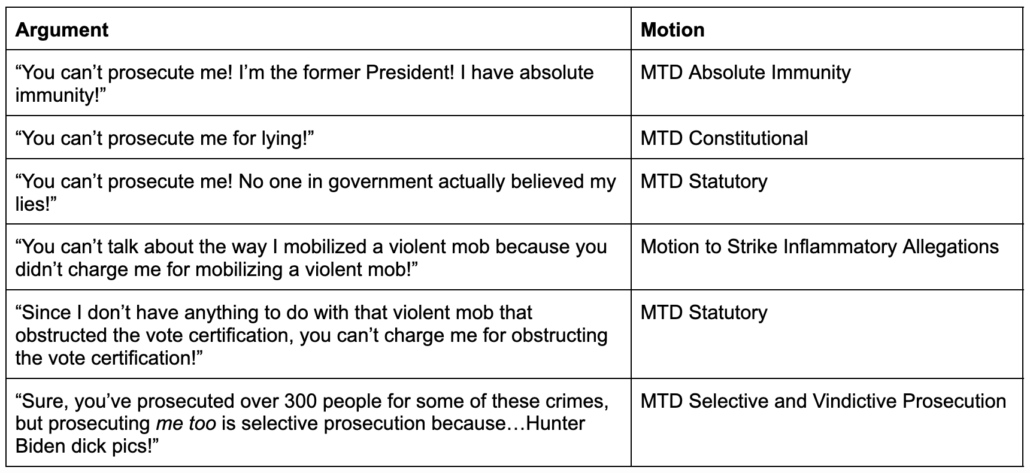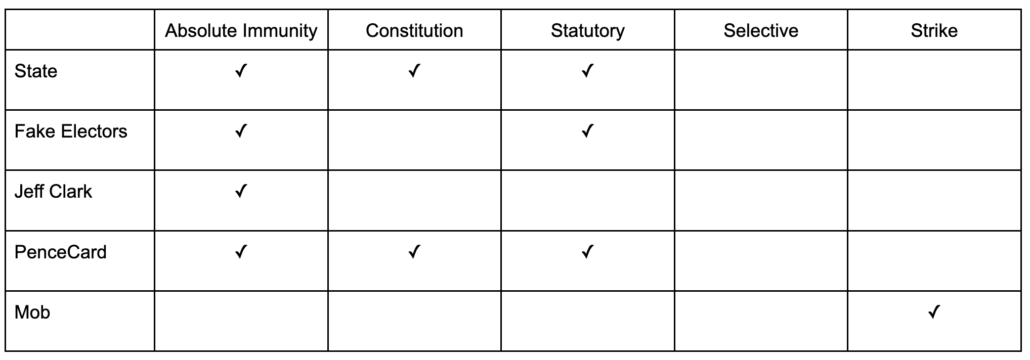Philip Bump notes that James Comer is now fundraising not just off his own conspiracy theories, but also Chuck Grassley’s.
Comer presents himself as a warrior for the truth, standing up to the media and the left-wing hordes, etc. Then the money ask appears.
Now, I track Comer and the Oversight Committee’s work more closely than most, so what struck me wasn’t that the chairman was trying to fundraise off what he was doing (he’s done that more than once in the past) but that he was trying to fundraise off this. After all, the allegation about the informants wasn’t something that came from his and his party’s efforts. The pitch couches that a bit, asserting in boldface text that “[i]t has come to light” that these informants purportedly existed. But there’s no news release about it from the normally news-release-enthusiastic House majority and no mention of it on Comer’s X/Twitter feed. The account for the Oversight Committee did mention it once, pointing back to the source of the claim: Sen. Charles E. Grassley (R-Iowa).
[snip]
That Comer is raising money off Grassley’s claim — raising money by exaggerating the claim to assert that there were 40 informants for 50 years — is the point. This wasn’t his work; it was simply an allegation that those who would respond to an “I’m fighting Biden for you” appeal would find compelling. I once referred to Comer’s efforts as a fishing expedition, but he’s not simply throwing out bait to see what he gets, he’s throwing out as much bait as he can to vacuum up as many fish as there are in the sea.
Actually, Comer is fundraising off Fox’s breathless regurgitation of Chuck Grassley’s conspiracy theories, which appeared in a letter to Chris Wray and Merrick Garland.
I find Bump’s observation notable for several additional reasons, beyond what Bump lays out.
First, it comes as Jamie Raskin’s whack-a-mole efforts to track Comer’s lies have gotten punchy. Monday, Raskin released a new 9-page letter listing the top lies Comer told after sniffing too many dick pics, to which the Maryland Congressperson appended the previous 12 letters Raskin sent debunking Comer’s bullshit.
- Falsely claimed that witness interviews actually conducted by Committee staff never happened;27
- Referred to a fugitive from justice charged with multiple felonies as a “very credible witness;”28
- Suggested you were present at a transcribed interview that you did not attend;29
- Repeatedly mischaracterized the statements of witnesses in interviews while refusing to publicly release interview transcripts; 30
- Claimed that the National Archives and Records Administration failed to turn over records to the Committee when they were actively cooperating;31
- Wrongly claimed that a transcribed interview suggested the President was involved in his family’s business dealings; 32
- Incorrectly asserted that suspicious activity reports, which you routinely mischaracterize as “bank violations,” implicate President Biden in wrongdoing; 33
- Dishonestly suggested that the President had the prosecutor of Ukraine fired as part of a bribery scheme;34
- Falsely accused the Biden-Harris Administration of obstructing the Committee’s investigation and interfering in U.S. Attorney Weiss’s investigation;35 and
- Falsely denied the existence of bank records in the Committee’s possession.36
See below for Raskin’s footnotes to just these 10 bullet points.
One reason the far right might stoke the conspiracy fires via Chuck Grassley rather than Comer is because Comer’s claims never last more than 20 minutes before Raskin or Dan Goldman expose them as nonsense. Grassley can make wildly unsubstantiated and often recycled and debunked claims and no one in the Senate will mock him for it.
But his claims are, if possible, even more ridiculous than Comer’s.
Take the headline claim — the one Comer is fund-raising off of: Chuck Grassley claims that the FBI sicced forty informants on Joe Biden, his brother, and his son.
As just one initial example, I’ve been made aware that at one point in time the FBI maintained over 40 Confidential Human Sources that provided criminal information relating to Joe Biden, James Biden, and Hunter Biden. An essential question that must be answered is this: did the FBI investigate the information or shut it down? Indeed, if those sources were improperly shut down, it wouldn’t be out of the ordinary for the FBI, as this letter will address.
Four-zero. Forty.
When just three informants interacted with Trump’s Coffee Boy as part of the Russian investigation, Republicans squealed about it for years. They claimed it was a gross weaponization of the FBI, not against Trump’s Coffee Boy (who told one of the informants, “I have to be an idiot not to monetize” access to Trump and “if [Trump] loses probably could be better for my personal business”), but Trump himself. But Chuck Grassley rolls out the claim that the FBI used forty informants against Biden and his immediate family, some known examples of which would have come during the period when Biden was the expected or declared candidate against Trump, and somehow he doesn’t see flashing sirens of abuse at the FBI?
🚨🚨🚨🚨
Nope. Instead, he’s sure that the FBI must have ignored those forty informants because they haven’t yet substantiated any crime against Biden and his family.
Grassley makes a similar move when he raises the FD-1023 he recklessly released this summer, which showed that Mykola Zlochevsky said something different in late 2019, probably during impeachment, than he had said earlier in the year. Grassley points to what he claims as confirmation from Bill Barr, Chris Wray, and Paul Abbate that there’s an ongoing investigation into the allegation as proof that it must have validity (in reality, Wray and Abbate appear to have been trying to protect the viability of this and all other informants, which Grassley instead decided he should burn to the ground).
The report, including information on the Biden family 1023, was ultimately transmitted to U.S. Attorney Weiss who, according to Attorney General Garland, had every investigative tool at his disposal even before being designated as a special counsel. 14
Since making the Biden family 1023 public on July 25, 2023, it’s been made clear by former Attorney General Barr, Director Wray, and Deputy Director Abbate that the 1023 is part of an ongoing investigative matter, indicating its investigative credibility and authenticity. 15 As such, it’s essential that we examine the alleged attempts by FBI personnel to sweep it under the rug, as well as what steps U.S. Attorney Weiss has taken to use the document for his ongoing investigation.
The one person who said there was an ongoing investigation pertaining to the FD-1023 was David Weiss, in a letter to Lindsey Graham. The fact that the guy in charge of the Hunter Biden investigation said this is a pretty good indication it hasn’t been swept under the rug.
As to the rest of Chuck Grassley’s claims, they have been almost entirely debunked by the House investigation.
For example, Grassley cites to his own letter about Joseph Ziegler and Gary Shapley’s testimony to support a claim that Lesley Wolf “prevented investigators from seeking information” about Biden’s involvement in what he claims were Hunter Biden’s “criminal arrangements.”
Also on October 23, 2020, Justice Department and FBI Special Agents from the Pittsburgh Field Office briefed Assistant U.S. Attorney Lesley Wolf, one of U.S. Attorney Weiss’s top prosecutors, and FBI Special Agents from the Baltimore Field Office with respect to the contents of the Biden family 1023. However, the meeting did not include any IRS agents, and AUSA Wolf prevented investigators from seeking information about Joe Biden ‘s involvement in Hunter Biden’s criminal arrangements. 18
What the evidence actually shows, however, is that agents blew off Wolf’s restrictions on references to the then-President-elect, and asked those questions anyway. In response, Hunter’s former partner, Rob Walker, told investigative agents that Joe was never involved in Hunter’s business. “I certainly never was thinking at any time the VP was a part of anything we were doing.”
But even that was a cherry-pick. After Shapley revealed that claim, Ziegler released the full Walker transcript (compare the excerpt from Shapley’s deposition with the full transcript released in September). The excerpt Shapley released at first left out critical details, details that impact Grassley’s complaints that Tony Bobulinski hasn’t been treated as a star witness.
The full Rob Walker interview makes it clear there was a whole lot of bad blood between Hunter Biden and Bobulinski that should raise questions about Bobulinski’s biases. At least per Walker — at the time (in 2017), Hunter believed that Bobulinski was too close to some Russians, which Walker explained that he treated as credible because the first time Walker met Bobulinski, Bobulinski was with someone claimed to be Viktor Vekselberg’s son.
Walker: …but ah.., um.., I.., I think that he was “blown off” because um.., ah.., Tony’s a.., an asshole…,
Wilson: (Laughs).
Walker: …um, but um.., you know, I think Hunter ah.., at one point, was ah.., um.., a little “bent out of shape” with Tony and ah..,
Wilson: Hmph hmph.
Walker: …granted he wasn’t in his.., his right mind but ah.., he thought that ah…, um.., Tony had some weird ah.., business background stuff…
Wilson: Okay.
Walker: …and Hunter did tell me that he had Tony, ah, checked out at one time…,
[snip]
Walker: …and he ah.., he thought that ah.., Tony was ah.., close or too close to ah.., ah.., some Russians.
[snip]
Walker: The first time, which it didn’t seem so unbelievable to me because the.., the.., the first time that I met Tony, um, I was in ah.., Las Vegas. Ah, James came over, um, and ah.., I had a friend from here come up with me and ah.., some people from Los Angeles came over that were friends of James. One was Tony and Tony was with ah, a kid named Alex and ah.., Tony didn’t tell me this but Alex was Russian and they thought it was ah.., or I was told it was ah.., Viktor…
Soline: Hmph hmph.
Walker: …Vexelberg’s (phonetic) son who was ah.., who Viktor is.., at the time he wasn’t on the sanctions list I’m sure.., but I think he’s been sanctioned now…
[snip]
Walker: …Tony’s background was that he.., ah.., you know.., had been pushing deals in the past in New York.., in and around New York.., and um.., ah.., with ah.., ah.., Russians and ah.., Russian money.
At the time Walker shared these details in December 2020, he was absolutely livid about Bobulinski’s public claims after the release of the “laptop,” so Walker’s comments shouldn’t be credited all that heavily either. But Walker temporally placed both Hunter’s suspicions about Bobulinski and the even earlier incident in Vegas years before Bobulinski’s Fox News media tour. Walker wasn’t insinuating that Bobulinski had ties to Russia because he was involved with the laptop caper; he was describing what he and Hunter believed three years before the laptop caper.
That’s important background to Grassley’s similarly unsubstantiated claim that Bobulinski’s testimony — at which he was represented by White House Counsel Stefan Passantino — matched something in Gary Shapley’s testimony.
On October 23, 2020, Tony Bobulinski met with and was interviewed by James Dawson, a Washington Field Office Special Agent in Charge, Acting Assistant Special Agent in Charge Giulio Arseni, Special Agent William Novak, and Special Agent Garrett Churchill. 16 Bobulinski provided first-hand knowledge as an eye and ear witness to Joe Biden’s involvement in potentially criminal schemes with Hunter Biden. Notably, on October 13, 2022, I wrote a letter to the both of you and U.S. Attorney Weiss with respect to a summary of Bobulinski’s FBI interview that my staff reviewed which included, in part, reference to the Biden’s receiving an unsecured $5 million loan, intended to be forgivable, from CEFC in 2017 that would serve as payment for actions Joe Biden took during his vice presidency. This financial strategy to illegally treat income as a loan is consistent with IRS whistleblower testimony that indicated Hunter Biden attempted the same with respect to other income, including payments received from Burisma. 17
It’s true that Shapley made this allegation over and over (it’s also true that Hunter did rely on loans as he grew more and more broke overcome by his addiction). But Ziegler’s testimony and David Weiss’ own explanation for not charging the earlier Burisma years revealed that the circumstances of the Burisma payments were not as clearcut as Shapley claimed.
[N]ow that the U.S. Attorney looked at the case, they don’t want to move forward with it.
And essentially what he told me is that not only are they not going to join the case and give us assistance — so give us another AUSA, give us someone to help there — they also told our prosecutors that they don’t think we have — that we can — or they don’t think that we have the charges — or not the ability, but the evidence for the charges to charge in D.C.
Then there are the other Grassley complaints that had already been debunked by Tim Thibault’s and other House witnesses’ testimony.
Grassley complains that “an avenue of derogatory Hunter Biden reporting” was ordered closed by Tim Thibault.
In that same letter, I noted that in October 2020, an avenue of derogatory Hunter Biden reporting was ordered closed at the direction of Assistant Special Agent in Charge Tim Thibault. My office has been made aware that FBI agents responsible for the information that was shut down were interviewed by the FBI HQ team in furtherance of Auten’s assessment.
Grassley doesn’t admit what Peter Schweizer has admitted: that he was the “avenue of derogatory … reporting” in question: Steve Bannon’s sidekick and propagandist (and so two degrees from two influence operations the FBI investigated, that of Andrii Derkach and that suspected of Guo Wengwui).
Schweizer is one of the 40 informants Grassley boasted about and the reason why he claims that the other 39 informants may have been shut down too.
Grassley seems to have botched the details about his handlers being interviewed by the Foreign Influence Task Force: Thibault tried to get them into the briefing, but FBI refused — in part because the daughter of one was posting related content on Daily Caller).
As Thibault testified, there were two reasons why he shut down Schweizer (based on whose book, Clinton Cash, Thibault had opened an investigation into Hillary in 2016). The first was that the Baltimore FBI team didn’t want Schweizer’s reporting, some of which was sourced to the laptop, because they already had the laptop and follow-on warrants and Schweizer’s involvement would only provide something Hunter’s attorneys might one day use to undermine the credibility of the inevstigation.
Here’s how Grassley twists what must be that discussion.
On October 5, 2020, Supervisory Special Agent Eric Miller and Assistant Special Agent in Charge Thibault participated in a call with the Washington Field Office; Baltimore Field Office; Wilmington, Delaware FBI agents; and FBI management personnel. That call allegedly included Assistant Special Agent in Charge Alfred Watson, Supervisory Special Agent Joe Gordon, Special Agent Susan Roepcke and Special Agent Joshua Wilson. Notably, FBI agents from the Baltimore Field Office were attached to U.S. Attorney Weiss’s investigation. My office has been informed that on that call it was confirmed the Delaware case currently run by U.S. Attorney Weiss was opened as a money laundering and Foreign Agents Registration Act case, not a bribery case as the Biden family 1023 would appear to require, and that it was jointly worked with the IRS. On that call, it was made clear that Delaware FBI agents were in possession of email evidence that contradicted denials made by Joe Biden that he was never aware of or involved in Hunter Biden’s business arrangements.
When Grassley said that the Delaware team was in possession of email evidence that, “contradicted Biden’s denials,” he meant they had the laptop and probably the iCloud warrant returns. There, too, he appears to be parroting Shapley’s claims about the laptop, which spun Hunter claiming to involve his father in business calls as proof that Joe was involved.
The other reason Thibault shut down Schweizer is because of what he learned in a Foreign Intelligence Task Force briefing that provided more context about things. Grassley claims that what persuaded Thibault was a Brian Auten assessment about disinformation that “improperly” discredited claims about Hunter Biden as disinformation.
On July 25, 2022, I wrote to the both of you.5 In that letter, I described whistleblower allegations that the FBI developed information in 2020 about Hunter Biden ‘s criminal financial and related activity but ultimately shut it down based on false assertions that it was subject to foreign disinformation. It’s been alleged that the basis for shutting the investigative activity down was an August 2020 assessment created by FBI Supervisory Intelligence Analyst Brian Auten. That assessment was used by an FBI HQ team to improperly discredit negative Hunter Biden information as disinformation and caused investigative activity to cease.
Yet Laura Dehmlow testified to the House that the claim that, “there was an assessment on Hunter Biden disinformation,” was inaccurate and agreed that, “the allegations … with respect to Mr. Auten are just wrong.”
Grassley ends with a claim that his story is based on “multiple credible whistleblowers” and a wail about political infection.
Based on the information provided to my office over a period of years by multiple credible whistleblowers, there appears to be an effort within the Justice Department and FBI to shut down investigative activity relating to the Biden family. Such decisions point to significant political bias infecting the decision-making of not only the Attorney General and FBI Director, but also line agents and prosecutors. Our Republic cannot survive such a political infection and you have an obligation to this country to clear the air.
But we know these whistleblowers aren’t credible. Several of them are undoubtedly agents disgruntled because Thibault shut down a propagandist as a source. One likely disgruntled agent — the aforementioned father whose daughter was reporting related content on Daily Caller — went to work for Heritage Foundation after he quit the FBI rather than be reassigned from a position where he could politicize public corruption investigations. Another chased the ItalyGate conspiracy theory long after Richard Donaghue debunked it. Ziegler and Shapley’s claims have been debunked by every witness who testified and a great many of the documents they themselves shared.
And that’s just the whistleblowers. Consider what we know about those forty informants. They definitely or may include (as Raskin partly addressed):
- Gal Luft, whose March 2020 claims came amid interviews where he also allegedly lied to the FBI
- The aforementioned June 2020 FD-1023 reporting a late 2019 statement from Zlochevsky that conflicted with things Zlochevsky had said earlier in 2019
- Steve Bannon flunky Peter Schweizer’s election 2020 season pitches
- Probably at least three Ukrainian sources that were part of Rudy’s campaign efforts
- People tied to Dmitry Firtash and Andrii Derkach
There may be localized people with their own political gripes, too; for example, in addition to metadata that could have been manufactured by anyone in possession of a “Hunter Biden” “laptop,” one reason the FBI treated John Paul Mac Isaac’s claims seriously was “intelligence” that said Hunter was in Delaware at the time.
The point being, even if the notion that the FBI used forty — 40!!!! — informants to investigate Donald Trump’s rival doesn’t set off alarm bells, the quality and the biases of the known informants should.
The House investigation has made it clear that Grassley’s credible whistleblowers aren’t credible whistleblowers. As DC US Attorney Matthew Graves charitably described it, Grassley’s sources delivered, “the garble that can happen when you layer hearsay on top of hearsay on top of hearsay. And when you look at a lot of this, it’s someone said that someone said that someone said.” The House investigation also made clear that at least some of Grassley’s forty informants aren’t credible sources, either.
And that may be why Republicans are recycling these debunked claims over in the Senate, where they’ll continue to churn up Fox viewers, but where they’ll avoid the scrutiny that has already debunked the claims in the House.
27 Letter from Ranking Member Jamie Raskin, Committee on Oversight and Accountability, to Chairman James Comer, Committee on Oversight and Accountability (Sept. 19, 2023) (online at https://oversightdemocrats.house.gov/sites/democrats.oversight house.gov/files/2023-09- 19.JBR%20to%20Comer%20re%20Schwerin%20Interview.pdf); see also House Republicans Downplay Meeting with Key Biden Aide, HuffPost (Sept. 19, 2023) (online at www huffpost.com/entry/eric-schwerin-oversightcommittee-joe-biden_n_65098430e4b0d98f39e80e1d).
28 Letter from Ranking Member Jamie Raskin and Rep. Dan Goldman, Committee on Oversight and Accountability, to Chairman James Comer, Committee on Oversight and Accountability (July 11, 2023) (online at https://oversightdemocrats.house.gov/sites/democrats.oversight house.gov/files/2023-07- 11.JBR%20Goldman%20to%20Comer%20re%20Luft.pdf); Rep. James Comer (@RepJamesComer), X (July 7, 2023) (online at https://twitter.com/RepJamesComer/status/1677414170411560962?s=20).
29 Rep. Dan Goldman (@RepDanGoldman), X (Aug. 7, 2023) (online at https://x.com/RepDanGoldman/status/1688667691584737280?s=20).
30 Memorandum from Democratic Staff to Democratic Members, Committee on Oversight and Accountability, Transcribed Interview of Former FBI Supervisory Special Agent (Aug. 16, 2023) (online at https://oversightdemocrats.house.gov/sites/democrats.oversight house.gov/files/2023-08- 16.Democratic%20Member%20Memorandum%20re%20FBI%20SSA%20Transcript.pdf); Transcript of Devon Archer Testimony Doesn’t Back Key Claims About Joe and Hunter Biden, PolitiFact (Aug. 4, 2023) (online at www.politifact.com/article/2023/aug/04/transcript-of-devon-archer-testimony-doesnt-back-k/); Devon Archer Said the Opposite of What Republicans Claimed, Washington Post (Aug. 3, 2023) (online at www.washingtonpost.com/politics/2023/08/03/devon-archer-transcript-biden/); Memorandum from Democratic Staff to Democratic Members, Committee on Oversight and Accountability, Oversight Committee Investigation into Presidential and Classified Records and Transcribed Interview of Former Executive Assistant to then-Vice President Biden (May 3, 2023) (online at https://oversightdemocrats.house.gov/sites/democrats.oversight house.gov/files/5.3.2023%20Chung%20Memo%20- %20FINAL.pdf).
31 Rep. Comer to Newsmax: Impeachment Inquiry Vote Possible Mid-Sept., NewsMax (Sept. 7, 2023) (online at www newsmax.com/Politics/newsmax-tv-biden-impeachment-inquiry/2023/09/07/id/1133671/); Committee on Oversight and Accountability Democrats (@OversightDems ), X (Sept. 8, 2023) (online at https://x.com/OversightDems/status/1700178556175692271?s=20).
32 Transcript of Devon Archer Testimony Doesn’t Back Key Claims About Joe and Hunter Biden, PolitiFact (Aug. 4, 2023) (online at www.politifact.com/article/2023/aug/04/transcript-of-devon-archer-testimony-doesnt-backk/); Devon Archer Said the Opposite of What Republicans Claimed, Washington Post (Aug. 3, 2023) (online at www.washingtonpost.com/politics/2023/08/03/devon-archer-transcript-biden/); Memorandum from Democratic Staff to Democratic Members, Committee on Oversight and Accountability, Transcribed Interview of Devon Archer (Aug. 3, 2023) (online at https://oversightdemocrats.house.gov/sites/democrats.oversight.house.gov/files/2023-08- 03.Democratic%20Member%20Memorandum%20re%20Archer%20Transcribed%20Interview%20Final.pdf).
33 The Faulkner Focus, Fox News (Apr. 21, 2023) (online at www.foxnews.com/video/6325510578112); Chairman James Comer (@RepJamesComer), X (Apr. 16, 2023) (online at https://twitter.com/jamescomer/status/1647645180260958211?s=46); Memorandum from Democratic Staff to Democratic Members, Committee on Oversight and Accountability, Chairman Comer’s Misuse and Distortion of Confidential Bank Information (May 10, 2023) (online at https://oversightdemocrats.house.gov/sites/democrats.oversight house.gov/files/2023.05.10%20Memo%20to%20Me mbers%20re%20Misuse%20and%20Distortion%20of%20Confidential%20Bank%20Information%20FINAL.pdf); Comer Releases Biden Family Probe Update Without Showing Link to President, Politico (May 10, 2023) (online at www.politico.com/news/2023/05/10/james-comer-biden-probe-00096067).
34 Fox and Friends, Fox News (Mar. 31, 2023) (online at https://video.snapstream net/Play/8cJmJQ9KSgTuI2622JTEza?accessToken=cr1lk3ctb7qf0); Jesse Watters Primetime, Fox News (July 3, 2023) (online at www foxnews.com/video/6330534582112); My Fellow Republicans: One Disgraceful Impeachment Doesn’t Deserve Another, Washington Post (Sept. 15, 2023) (online at www.washingtonpost.com/opinions/2023/09/15/congressman-ken-buck-biden-impeachment/); Debunking 4 Viral Rumors About the Bidens and Ukraine, New York Times (Oct. 29, 2019) (online at www.nytimes.com/2019/10/29/business/media/fact-check-biden-ukraine-burisma-china-hunter.html); Memorandum from Democratic Staff to Democratic Members, Committee on Oversight and Accountability, Chairman Comer and Senator Grassley’s Decision to Publicly Release FBI Form FD-1023 (July 24, 2023) (online at https://oversightdemocrats.house.gov/sites/democrats.oversight house.gov/files/2023-07- 24.Dem%20Memo%20re%20Comer%20Grassley%20Letter%20FD-1023_.pdf).
35 Sunday Morning Futures, Fox News (Aug. 20, 2023) (online at www.foxnews.com/video/6334869612112); Kudlow, Fox Business (June 29, 2023) (online at www.foxbusiness.com/video/6330314725112); The Daily, New York Times (Sept. 15, 2023) (online at www.nytimes.com/2023/09/15/podcasts/the-daily/biden-impeachment html?showTranscript=1); McCarthy Launches Biden Impeachment Inquiry—With Zero Evidence, New Republic (Sept. 12, 2023) (online at https://newrepublic.com/post/175504/mccarthy-biden-impeachment-inquiry-no-evidence-not-enough-votes); Memorandum from Democratic Staff to Democratic Members, Committee on the Judiciary and Committee on Oversight and Accountability, IRS and FBI Witnesses Debunk Republicans’ False Claims About Political Interference in Special Counsel Weiss’s Investigation (Sept. 27, 2023) (online at https://oversightdemocrats.house.gov/sites/democrats.oversight house.gov/files/2023-09- 27%20Joint%20Democratic%20Memorandum%20re%20IRS%20and%20FBI%20Witnesses%20Debunk%20Politic al%20Interference%20Claims.pdf).
36 Mornings with Maria, Fox Business (Oct. 25, 2023) (online at www.youtube.com/watch?v=gFkB5qFBhaQ); Letter from Ranking Member Jamie Raskin, Committee on Oversight and Accountability, to Chairman James Comer, Committee on Oversight and Accountability (Oct. 26, 2023) (online at https://oversightdemocrats.house.gov/sites/democrats.oversight house.gov/files/2023.10.26.%20JBR%20to%20Com er%20re.%20Subpoenas.pdf); GOP Touts Bombshell Biden Payments—But Records Suggest Otherwise, Messenger (Oct. 26, 2023) (online at https://themessenger.com/politics/gop-touts-bombshell-biden-payments-but-recordssuggest-otherwise); Another GOP “Bombshell” About Joe Biden Turns Out to Be a Dud, HuffPost (Oct. 23, 2023) (online at www huffpost.com/entry/james-biden-payment-joe-biden_n_6536badee4b0689b3fbd8cf1).

